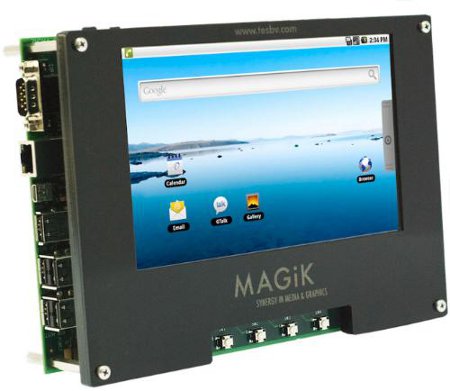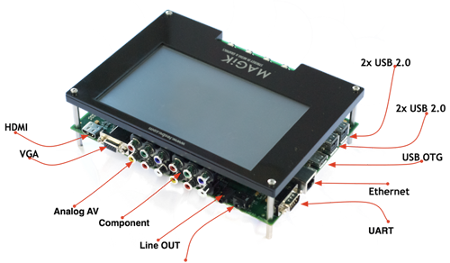Linux/Android HMI kit upgrades to 1GHz Cortex-A8 SoC
Nov 3, 2010 — by Eric Brown — from the LinuxDevices Archive — 16 viewsTES Electronic Solutions announced a new member of its Linux- and Android-ready “Magik” computer-on-module (COM) and HMI development kit family, this time with TI's DaVinci DM3730 system-on-chip. The Magik-MX-37 COM has 512MB RAM and up to 1GB of flash storage, and the compete kit offers a seven-inch, 800 x 480 capacitive touchscreen plus I/O including Ethernet, USB, and HDMI.
As with the Texas Instruments (TI) OMAP3530-based Magik-MX kit (announced in February, and now called the Magik-MX-35), the Magik-MX-37 combines a COM and an I/O subsystem. The company also offers a Magik-MX-27 COM and module that incorporates a Freescale i.MX27 system-on-chip (SoC).

Magik-MX-37 kit
Like the Magik-MX-35, the Magik-MX-37 is designed for medical, industrial, home automation, transportation, and high-end consumer applications, says the company.
The Magik-MX-37 module incorporates the DaVinci DM3730 SoC, which can be considered the heir to the OMAP3530. The DaVinci DM3730 uses a 1GHz Cortex-A8 core (up from 600MHz or 720MHz on the OMAP3530), and provides a faster 800MHz C64x+ DSP (digital signal processor) core.
Unlike the OMAP3530, the DM3730 supports video recording and playback at 720p quality, says TI. The DM3730 improves performance over the OMAP3530 thanks to 45nm fabrication, as well as more Level 1 cache, and a faster frequency for its SDR controller. The SoC is also claimed to draw 40 percent less power than the OMAP3530.

Magik-MX-37 COM
In addition to providing the seven-inch touchscreen, the full Magik-MX-37 Kit offers HDMI, RCA, and component video I/O, a microSD slot, and an Altera Cyclone III FPGA (field-programmable gate array), said to offer "generic expansion." The device also provides an Ethernet port, four USB 2.0 Host ports, a USB OTG port, and a UART, says the company.

Magik-MX-37 kit, port detail
Specifications listed for the Magik 37 Kit include:
- Processor — TI DM3730 with ARM Cortex-A8 @ up to 1GHz
- Memory — 512MB Mobile DDR (166MHz) memory
- Flash — 512MB or 1GB NAND flash; 64MB NOR flash; SD interface
- Display:
- 7-inch 800 x 480 capacitive touchscreen
- HDMI port
- 2 x RCA I/O
- component video
- Networking — 10/100 Ethernet port
- Other I/O:
- 4 x USB 2.0 high-speed host port
- 1 x USB 2.0 high-speed On-the-Go (OTG) device port
- 1 x UART
- Audio — I2S compliant audio codec (TI TWL4030 with 16-bit stereo DAC, 13-bit ADC)
- Options — Wi-Fi, Bluetooth, or 3G modems; DECT and CATiQ 2.0 via USB/SPI interfaces
- Power Supply — 5v power supply, with on-board power management
- COM dimensions — 3.54 x 1.96 inches (90 x 50mm)
- Operating temperature — 32 to 158 deg. F (0 to 70 deg. C); ext. temp version -40 to 185 deg. F (-40 to 85 deg. C)
The Magik-MK-37 Kit ships with a software development kit (SDK) that offers TES' open source Magik OS, which integrates a Linux kernel 2.6.29, and is extendable with an Android 2.2 implementation. Unlike the Magik-MX-35, the Magik-MX-37 does not appear to currently support Windows Embedded CE.
SDK features include an API for OpenGL ES 1.1 and 2.0, as well as the Guilani GUI framework and editor for HMI (human machine interface) applications. Additional features include GStreamer, and PacketVideo's OpenCore multimedia framework integrated with MPEG-4, H.264, MP3, and AAC codecs for Linux and Android. (For more information on the Magik stack available, see our previous coverage, here.)
Stated Martin Gassner, director sales and marketing at TES-DST, "An upgrade to the DM3730 offers our customers enhanced performance, low power and flexibility of using an existing software stack."
Stated Vineet Ganju, product marketing manager, C6000 products, TI, "The MAGiK production-ready reference design, based on high-performance TI analog, power management and DaVinci DM3730 media processors, combined with TES' manufacturing services, is already helping worldwide customers accelerate time-to-market for their products."
Availability
The Magik-MX-37 development kit is now available priced at 1099 euros ($1,540). More information may be found here. A free evaluation kit to develop rich UI solutions on OMAP and DaVinci platforms is said to be available here.
This article was originally published on LinuxDevices.com and has been donated to the open source community by QuinStreet Inc. Please visit LinuxToday.com for up-to-date news and articles about Linux and open source.